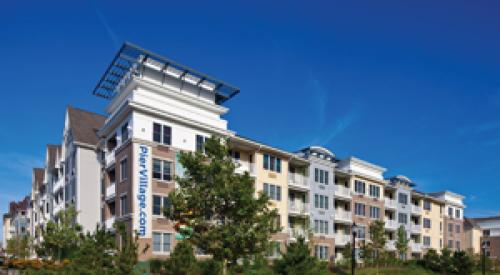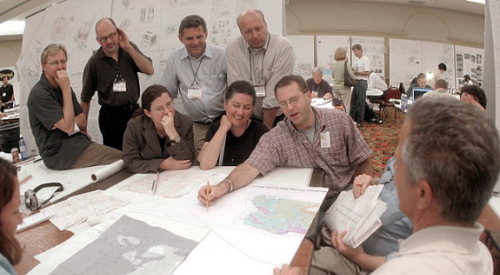| Lakewood Ranch in Sarasota, Fla.
|
Master-planned communities (MPCs) can make a strong impression. A fictional MPC was the subject of a television show: a recent episode of "The X-Files" about the mysterious disappearance of residents who failed to comply with community guidelines.
Real MPCs, of course, are not the stuff of science fiction; if they attract attention, it’s because of their popularity with home buyers. While there is no national data proving they have a larger market share than conventional subdivisions, in certain areas, such as Las Vegas, Phoenix and Orange County, Calif., MPCs can make up as much as 40% to 70% of the market, says Bob Gardner, senior vice president of Robert Charles Lesser & Co., Los Angeles, a real estate advisory firm.
No single definition of "master-planned community" satisfies everyone. A broad definition would be a community that has a mix of housing types and amenities. According to Toni Alexander, principal of InterCommunications Inc., a public relations and marketing firm in Newport Beach, Calif., a true master plan is self-sustaining, with a variety of components (housing, places of employment, schools, shopping, recreation) that allow people to live, work, play and learn in the same community. Many communities that are called master plans, she says, are actually planned unit developments with recreational components.
| Northwest Landing in DuPont, Wash.
|
"‘Master-planned’ means it’s not done in bits and pieces," says Alexander, who is chairman of the Community Development Council for the Urban Land Institute (ULI). "You look at the whole picture to define what the planning pods are going to be and what goes where."
The ULI and Lesser recently surveyed MPCs of 300 acres or more, with a mix of housing types and recreational amenities. Long life spans are common with master plans; those in the survey averaged almost 17 years from entitlements to buildout--a good indication of the degree of planning and capital necessary to execute such a project. The Sunbelt states remain the hot spots for MPC development because MPC sales parallel land availability and metropolitan growth trends.
"That’s why you don’t find too many MPCs in the Northeast," says Gardner. "However, you do find them in Seattle and Denver, growing markets with land-use patterns that are similar to other growing regions in the Sunbelt."
| Summerlin in Las Vegas
|
According to the ULI/Lesser survey, the average size of MPCs varies by market orientation (primary, retirement and vacation/resort), but residential is the dominant land use form regardless of orientation--about 73% of the developed acreage.
Despite talk of a decline in mammoth master plans, Alexander knows of projects under development that are well over 1000 acres. However, this varies from region to region. Marketing consultant Gary Ryness, principal of the Ryness Co., Danville, Calif., says there are more MPCs in the San Francisco Bay area and Sacramento now than there were five years ago, but they’re smaller. Instead of 4000 to 5000 units, communities are now 1000 units or less--actually more in the range of 300 units, says Ryness.
"The bigger the community, the more problems there are with environmentalists," he says.
Despite their smaller size, these communities are still considered master plans because of the number of features provided, such as entry gates, boundary walls and extensive landscaping. A 300-unit MPC can include three distinct neighborhoods of 100 houses each. Even in a master plan of that size, many municipalities demand a certain amount of commercial space, Ryness says.
Higher Perceived Value
Home builders are attracted to master plans for a number of reasons, Alexander says. Zoning is usually established, so the builder doesn’t have to take the project through the approval process. Improvements such as swimming pools and parks are done by the developer. And, builders can take advantage of shared marketing costs; the developer shoulders the expense of putting in an information center and creating an image and marketing strategy for the community.
"Of course, builders are still paying that per-pad cost, but they can focus on doing what they do best: building houses," she says. "Once they’ve done well in a master plan, they’ve got a continuing land bank at no extra cost--in other words, they don’t have to carry the land until they can get to it. The developer pays the carrying costs."
A smart and savvy developer, says Alexander, will segment the market so that there is a wide spectrum of housing available to buyers, and carefully select builders who can deliver the most value-added product.
"In a master-planned community, there is an opportunity for people to buy homes at different stages of their careers and lifestyles," she says.
Weyerhaeuser Real Estate Co., developer of Northwest Landing, an MPC near Seattle (see page 42), surveys all new residents as they move in. Asked why they chose the community, residents who took occupancy in the first quarter of 1999 gave the following answers, in order of importance:
- Trails, sidewalks and parks
- Master-planned community
- Neotraditional architecture
- Proximity to work
- Community landscaping
- Investment potential
- Potential for a simpler life
"Planned" is a key word in understanding the appeal of these communities to the public. "Our homeowners like the fact that it’s all planned," says Christine Hall, director of marketing for Northwest Landing. "They know where the single-family homes, condominiums, recreation, businesses--everything they might need--are going to be. It gives them a good level of comfort that something undesirable won’t be built right behind their house."
Alexander adds, "There’s the assurance of orderly growth, plus the benefit of a wider range of amenities. Homeowners feel their investment is protected." Most MPCs also have some type of security, such as a gatehouse with a 24-hour guard, a roving patrol or a neighborhood watch program.
In this article, the editors of PB profile four communities on the leading edge. Find out why Summerlin, Lakewood Ranch, Hamilton and Northwest Landing are four of the best-selling master plans in the country.
See related article:
New Town Woven into Old Town
New Urbanism Thrives in Pacific Northwest
Behemoth Bags Buyers
Hot Town--Summerlin City












